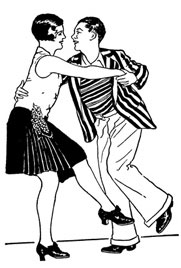We cannot communicate without movement. When all else fails, we resort to gesture, for everyone understands a shaking fist or a baby's pointing finger. Although we may infer from a twitch that someone is experiencing a nervous tic, it is not an intentional act. Movement is metafora when it acts as a conduit between two people, when it acts to convey expression.
Like spoken language, some gestures require a common understanding between the sender and the recipient of the message. Touching your thumb and middle finger together means "OK" in the West, while in Arab countries it suggests the evil eye. Such gestures depend on an arbitrary relationship established by culture. They are not, in the terms of Charles Peirce's (American linguist and philosopher, 1839-1914) theory of semiotics, indexical like a grimace. Indexical signs indicate the presence of something else: smoke indicates fire, a grimace indicates pain. Systems of gestures can become languages, as in the case of highly structured, nonverbal American Sign Language, in which gestures have agreed-upon meanings by those who understand ASL.
- J.D. Salinger (American author, born 1919),
Catcher in the Rye

If we accept that gesture and dance are the primal examples of expressive movement, further investigation reveals how they evolve in other forms. Think of the power of Jackson Pollock (American abstract painter, 1912-56) as he thrusts paint onto a blank canvas or the precision of stroke in the hand of a calligrapher. The integration of eye, hand, and mind is an integral part of the intentional act of writing. Theater is an obvious extension of primitive dance and storytelling; and cities and their architecture grow out of the necessity to enable movement, even though they sometimes fail. We can see the beauty of movement in everyday acts or in the golf swings of Tiger Woods (American golfer, born 1975).
Though the computer itself does not move (although digital circuitry controls all manner of self-moving devices), it can depict movement, and it demands a physical dexterity. Interactions with early computers such as ENIAC required direct physical manipulation of the computer's wires in order to program it; later computers allowed interaction through a keyboard. The computer mouse, invented by Douglas Engelbart's (American engineer, born 1925) Human Factors Research Center in 1965, transferred the motions of the user's arm into the virtual space of the computer screen. This electrification of motion is one of the great inventions of the twentieth century, as it used the metaphor of gesture to control the computer. Console video games amplify movement—the press of a button on an Xbox or PlayStation causes the player's avatar to swing a bat or run or jump. Minute gestures become significant movement. In early 2006, Nintendo released the Wii game console. Realizing they could not compete with Sony or Microsoft in terms of graphics, Nintendo changed the interface metaphor. While earlier computer games used buttons to control the action, the Wii allows the user to swing the controller itself. A nation of couch potatoes has gotten up off their seats.
Today, the vistas of cyberspace stretch before us like so much unexplored territory. The computer allows amplification of the human gesture. Our motions through and in cyberspace have the potential, if they are thoughtful, to create meaning through the ways we move and, therefore, interact with others.
- Havelock Ellis (British doctor, sexual psychologist and social reformer, 1859-1939), The Dance of Life
